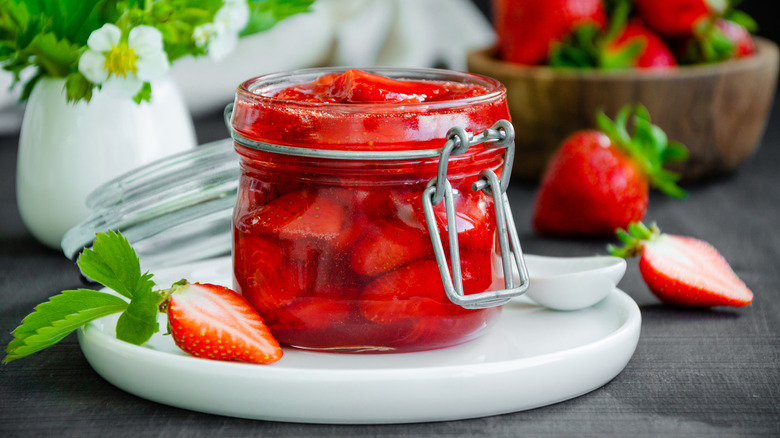How Long Do Home-Canned Strawberries Last?
Strawberries are a hallmark of summertime sweets, so it's no wonder why folks miss them when the growing season is over. If you want to enjoy a cheerful strawberry cobbler on Valentine's Day (which is months after the season has ended in July) then you'll want to get into home canning. This is because, according to the USDA, the practice can save you around half the cost compared to buying commercially canned fruits. Canning also keeps strawberries' natural vitamins intact. When properly canned, the USDA maintains that your produce can have even more nutritional value than many fresh offerings sold in grocery stores. If you need another reason to give it a try — it's a cozy and fun way to spend an afternoon.
Canned strawberries are a versatile ingredient to have on hand year-round. While the uses of canned strawberry jam are pretty much limited to spreading on toast and croissants, canned whole strawberries can be used in salads, baked goods or enjoyed straight from the jar. Practical Self Reliance recommends using the berries in pie fillings, tarts, over pancakes, or as a strawberry cheesecake topping.
Canning is a great space-saving way to minimize food waste, too. If, during season, your strawberry patch is popping out berries faster than you can eat them, a one quart jar can fit two-to-three pounds (roughly four cups) of fresh, hulled strawberries. But, how long will those home-canned strawberries last?
Strawberries all year round
Clemson University maintains that home-canned strawberry jam will keep in the refrigerator for three weeks. But when properly canned and frozen or stored in a cool, dry place, they'll last for up to one year. It's roughly the same time frame for canned whole berries, as well. According to Little Home in the Making, home-canned strawberries last for a minimum of 18 months but can keep for as long as a few years. If your jar's seal is looking good and the strawberries aren't showing any signs of spoilage (i.e. discoloration, visible molding, or significant changes in texture), they're safe to eat. For optimal results, the USDA recommends storing your canned produce between 50 to 70 degrees Fahrenheit, but they still shouldn't spoil if kept below 95 degrees Fahrenheit.
Luckily, strawberries have naturally high acidity, with a pH of around 3-3.5, per Tastylicious, which makes them more resistant to botulism during canning, according to the USDA. Admittedly, after the first year, those strawberries aren't going to be looking as pretty as they did in the garden, but they'll still be safe to enjoy. For a cosmetic boost, Healthy Canning recommends adding a little ascorbic acid (aka vitamin C powder) to your solution to help those strawberries retain their color during storage. If you're feeling adventurous, you can even try pickling them.

